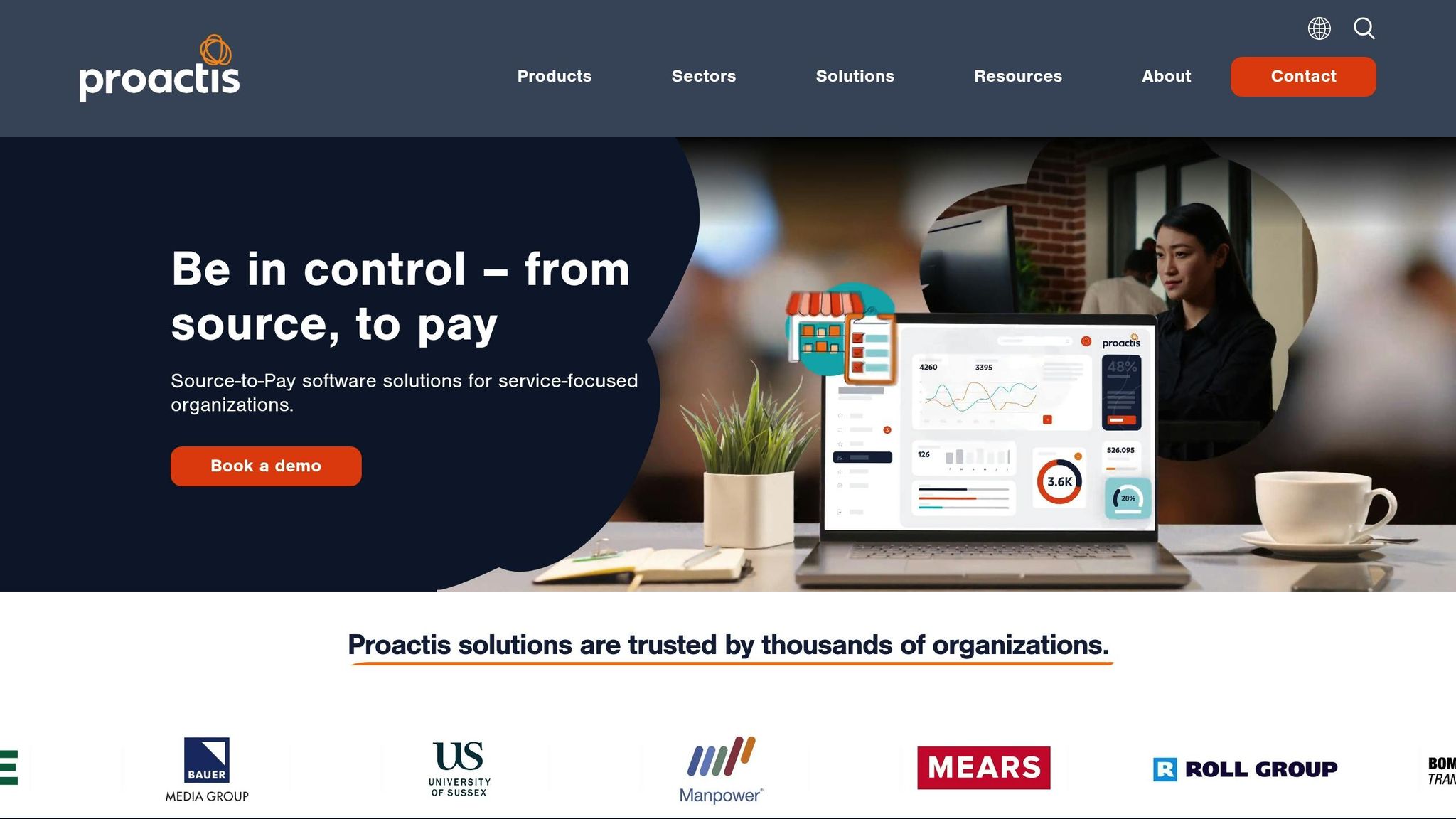
Integrated sourcing systems simplify supply chain management by connecting suppliers, manufacturers, and customers through a single platform. They improve visibility, reduce costs, and enhance decision-making. Here are the six key benefits:
- Improved Visibility: Real-time data helps monitor supplier performance, inventory, and procurement pipelines, reducing inefficiencies and risks.
- Faster Procurement: Automation eliminates manual bottlenecks, streamlining order processing, approvals, and supplier communication.
- Stronger Supplier Collaboration: Tools like real-time messaging and shared dashboards improve communication, reduce errors, and speed up responses.
- Accurate Cost Estimation: Automated calculations and analytics provide precise cost insights, improving budgeting and supplier negotiations.
- Data-Driven Decisions: Advanced analytics and predictive tools enable smarter, faster responses to supply chain disruptions.
- Scalability: Cloud-based systems grow with your business, integrating seamlessly with existing tools and automating routine tasks.
These systems are transforming industries like aerospace, medical devices, and automotive by addressing complex supply chain challenges, ensuring compliance, and supporting growth without disruptions.
The Benefits of Integrated Source-to-Pay | Proactis

1. Better Supply Chain Visibility
Keeping a close eye on supply chains has become a game-changer for manufacturers. Real-time visibility, powered by integrated sourcing systems, offers instant access to critical details at every step of procurement and production.
Real-time Data Visibility
The backbone of integrated sourcing is real-time data, which makes supply chains more transparent and efficient. These systems provide a clear, up-to-the-minute view of supplier performance, delivery schedules, inventory levels, and procurement pipelines. With this level of insight, organizations can quickly spot spending trends, uncover cost-saving opportunities, and address inefficiencies. Plus, it helps with demand planning, minimizing risks like running out of stock or over-ordering. By creating this transparency, businesses can also implement automated monitoring to further fine-tune their operations.
Automation of Processes
Automation bridges the gaps left by manual tracking, streamlining procurement activities and cutting holding costs. It enables automated tracking of key metrics like supplier performance, delivery timelines, and quality standards, helping businesses catch potential issues early. Additionally, workflows that link procurement with budgeting and financial systems provide a complete picture of sourcing decisions. When paired with analytics, automation turns raw data into meaningful insights that drive better outcomes.
Analytics and Decision Support
Advanced analytics take raw supply chain data and turn it into powerful insights. These tools generate detailed reports on supplier performance and quality metrics, while predictive analytics flag potential disruptions so businesses can make timely adjustments. Spend visibility tools within these systems help monitor expenses and identify ways to save money. By connecting procurement, inventory, and logistics, manufacturers can plan smarter and respond more quickly to changes.
2. Faster Procurement Processes
Integrated sourcing systems have transformed procurement by removing bottlenecks and simplifying workflows. What used to be slow, manual processes are now efficient, automated operations that save both time and resources.
Automation of Processes
One of the standout advantages of integrated systems is the automation of tasks that once dragged down procurement cycles. These systems handle orders, requisitions, invoices, and approvals with speed and precision, significantly reducing errors and cycle times.
By eliminating redundant approval steps, automated workflows allow purchase orders to be placed faster. This shift not only shortens the overall process but also frees procurement teams to focus on more strategic, high-impact projects instead of getting bogged down by administrative chores.
"Real-time data is no longer optional. It is the cornerstone of effective supply chain management." – Real Time Intelligence (RTI)
Cloud-based procurement software takes this a step further by seamlessly integrating with other business systems, enabling smooth data sharing. With advanced tools like Robotic Process Automation (RPA), companies can make decisions instantly, combining speed with accuracy.
Real-time Data Visibility
Having access to real-time information has revolutionized procurement decision-making. Teams can instantly view critical data, enabling them to act decisively.
However, many businesses still lag in this area – 76% lack full visibility across their supply chains, and only 31% frequently use real-time data. For those that do, the results are striking: teams can respond to supply disruptions up to 80% faster.
The financial impact is equally compelling. Real-time data can cut stockouts by 50%, lower emergency shipping costs by 30% or more, and boost on-time delivery rates to 98% or higher. It also trims inventory carrying costs by 15-25% and reduces manual data entry by 40-60%. With these insights, supplier interactions become more streamlined and responsive.
Supplier Collaboration Tools
Modern integrated systems also come equipped with collaboration tools that speed up communication and decision-making with suppliers. Features like real-time messaging, centralized communication hubs, and instant chat functions eliminate delays and miscommunications that often plague procurement processes.
Automated document generation for RFAs (Request for Authorization), RFQs (Request for Quote), and RFIs (Request for Information) accelerates the sourcing process. Suppliers, in turn, can use dedicated portals to quickly respond to bids and manage their profiles, catalogs, and pricing.
"Procurement collaboration tools are transforming the way businesses manage their purchasing activities, facilitating smoother communication, faster decision-making, and enhanced efficiency across departments." – TYASuite
AI-driven features within these tools further enhance efficiency. They suggest vendors, automate contract reviews, and analyze supplier bids, enabling smarter, faster decisions.
The global cloud logistics market is projected to hit approximately $46.3 billion by 2030, growing at an annual rate of 13.6% from 2025. Companies adopting strategic sourcing platforms often see quick results, with 99% of surveyed users reporting ROI within the first year.
These collaboration tools, paired with automation and real-time data capabilities, create a seamless procurement process. When suppliers have instant access to information and can respond quickly, the entire cycle accelerates, leading to faster fulfillment and improved efficiency across operations.
3. Better Supplier Collaboration
Strong supplier relationships are the backbone of manufacturing success. Integrated systems simplify these partnerships by creating clear and efficient communication channels for sharing data, benefiting both buyers and suppliers alike. By leveraging real-time data, these systems take supplier interactions to a whole new level.
Real-time Data Visibility
Integrated systems give suppliers real-time access to crucial information like order details, shipping schedules, demand forecasts, inventory levels, and quality control data. This level of transparency helps eliminate the guesswork that often causes miscommunication and delays.
Despite these advancements, 76% of businesses still lack full visibility across their supply chains. This gap presents a huge opportunity for improvement.
Nike set a great example in March 2025 when they implemented a Supplier Relationship Management (SRM) system to enhance collaboration with their global supplier network. By sharing real-time demand data through this system, Nike optimized production planning and responded swiftly to market changes. Suppliers were equipped with the latest demand trends, enabling them to adjust production schedules and inventory levels effectively.
"Supply chain visibility also provides a base of information that trading partners can use to work together, ensuring that all parties can act quickly and with informed confidence." – SAP
Supplier Collaboration Tools
Integrated sourcing systems come packed with tools that make supplier collaboration smoother and more efficient. These platforms replace outdated methods like emails, spreadsheets, and phone calls with a centralized hub for communication and information exchange.
- Purchase order collaboration: Suppliers can review, confirm, or request changes to orders at the line-item level, with updates automatically synced to the buyer’s ERP system.
- Forecast collaboration: Real-time sharing of demand changes allows suppliers to plan ahead and avoid excess inventory.
- Quality management tools: Buyers and suppliers can quickly address quality issues, resolve exceptions, and track performance using dashboards and scorecards.
AI-driven features further enhance collaboration by predicting delivery risks, automating inventory replenishment, and providing proactive demand signals. According to JAGGAER, these tools deliver impressive results, including a 75% reduction in purchase order errors and 30% savings in goods receipt management efficiency through automation.
"We do not limit collaboration with suppliers to data exchange or sourcing-related logistics, but rather search for new ways to increase the value of all collaboration partners." – Lothar Färber, Vice President, Procurement, Carl Zeiss AG
Analytics and Decision Support
Integrated analytics go beyond communication, offering powerful insights that strengthen supplier partnerships. Real-time metrics on delivery timeliness, product quality, and compliance allow businesses to objectively evaluate suppliers and identify areas for improvement.
Zero-latency dashboards enable companies to share procurement data with internal and external partners, improving visibility into cost-saving opportunities and accelerating planning decisions. "What-if" modeling tools allow businesses to explore potential savings from different sourcing strategies and assess risks before making decisions.
These analytics benefit both buyers and suppliers. For instance, when suppliers’ on-time in-full (OTIF) performance falls below 90%, collaboration tools can make a significant difference. Yet, 75% of companies admit their supply chain collaboration efforts are still "a work in progress", leaving plenty of room for growth.
"Transparency improves supplier relationships by moving from adversarial blame-focused interactions to collaborative problem-solving. When both parties can see the same real-time information, discussions focus on solutions rather than finger-pointing." – Pallite Group
"When all parties have access to the same real-time data, supply chain processes become more streamlined, leading to stronger partnerships and improved supplier performance." – ASCM
As with other integrated sourcing tools, improved supplier collaboration doesn’t just streamline operations – it also leads to smarter, more informed decision-making.
4. More Accurate Cost Estimation and Savings
Integrated systems are transforming cost estimation in manufacturing, making it more precise and impactful for profitability. Accurate cost estimates can make or break a manufacturing business, yet traditional methods often fall short. In fact, only 17% of manufacturers express strong confidence in their cost estimates, while 52% acknowledge that their initial projections frequently miss the mark. Integrated sourcing systems address this gap by delivering precise, data-driven insights that streamline processes and support smarter decision-making.
Cost Estimation Accuracy
Relying on spreadsheets and manual calculations for cost estimates is outdated and inefficient. Traditional quoting processes often take 12 to 20 weeks, with up to four weeks wasted waiting for supplier responses. This slow pace creates bottlenecks and limits competitiveness in fast-moving industries.
Integrated systems tackle these challenges by automating calculations and using real-time data. Tools like "should cost" analysis break down expenses into materials, labor, overhead, and processes, giving manufacturers a clear benchmark for negotiations. This helps identify when supplier quotes deviate from expectations, ensuring better control over costs.
For example, Thompson Aero Seating adopted advanced costing tools in 2025 and achieved remarkable results. Within just two months, they slashed costs on their 50 most expensive machined parts by 40%, leveraging should cost analysis to drive supplier discussions. This case highlights how precise data can lead to immediate and substantial savings.
Automation of Processes
Automation plays a key role in improving cost estimation accuracy by removing manual delays and reducing errors. Integrated systems pull data from engineering, procurement, and production databases, creating a unified, automatically updated source of truth.
This efficiency can drastically reduce delays. In 2025, a global Tier-1 automotive supplier cut RFQ response times from 90 days to just 5 days. Similarly, Flex increased their RFQ win rates from 15% to an impressive 68% through automation.
Over time, machine learning enhances these systems further. By analyzing historical data and recognizing patterns, these tools continuously improve their predictive accuracy.
Analytics and Decision Support
Advanced analytics turn raw cost data into actionable insights, empowering manufacturers to make informed decisions. Integrated systems offer "what-if" scenario modeling, allowing businesses to explore how variables like commodity price changes, labor shifts, or design modifications impact costs before committing to decisions.
These analytics are especially valuable during the design phase, where about 80% of a product’s total cost is determined. By using precise cost insights early, manufacturers can adopt "Design to Cost" strategies, setting clear cost targets and addressing potential cost drivers upfront.
Real-world examples underscore the benefits of this approach. A major Aerospace and Defense contractor saved between $2.7 million and $8.7 million over three years by negotiating cost reductions of over 10% on vendor quotes.
Signify, a global leader in lighting, expanded their should cost analysis capabilities eightfold in 2025 using automation-driven platforms. This allowed them to optimize costs across their entire product range, proving that integrated systems can scale with business needs.
Carrier is also seeing impressive results, projecting savings of around $30 million in critical product development projects through the use of integrated cost management platforms across design and sourcing. These examples demonstrate how accurate cost estimation not only boosts profitability but also provides a competitive edge in the marketplace.
sbb-itb-827f251
5. Data-Based Decision-Making
For manufacturers to stay competitive, relying on data to guide decisions is no longer optional – it’s essential. Integrated systems provide more than just cost accuracy; they enable smarter, strategic choices by offering real-time insights and analytics. These tools are transforming how companies approach procurement and supply chain management.
Real-time Data Visibility
Having real-time visibility into supply chain operations gives manufacturers an edge. From raw materials to final delivery, this level of insight means companies can tackle potential problems before they escalate. It’s like having a constant pulse on the entire operation.
Here’s an eye-opening stat: companies with real-time supply chain visibility are 2.5 times more likely to be top performers. Despite this, many businesses still struggle to achieve complete visibility across their operations.
The benefits of real-time data are clear. Manufacturers can cut stockouts by up to 50% and hit on-time delivery rates of 98% or more.
Take, for instance, a grocery transport company that equipped its trucks with smart temperature sensors. These sensors monitored conditions in real time, sending instant alerts to operators. If a problem arose, they could reroute or fix the issue before it led to spoiled goods. The result? Fewer losses, happier customers, and preserved capital. Similarly, an e-commerce company used real-time tracking for last-mile deliveries, slashing delivery times by 20%. This not only saved on fuel costs but also delighted customers with live updates on their packages.
Analytics and Decision Support
Advanced analytics go beyond crunching numbers – they transform raw data into actionable insights. By tapping into AI and machine learning, manufacturers can predict market trends, evaluate supplier risks, and refine procurement strategies.
"The true power of real-time data lies in its ability to inform smarter, faster decisions. This is particularly vital for supply chain leaders who must constantly balance cost, speed, and service." – rtintel.com
Strategic sourcing analytics can lead to significant savings – cutting procurement costs by up to 15%. They also address supplier visibility gaps, which affect 35% of companies. With these tools, businesses can keep a close eye on supplier performance, quickly identify inefficiencies, and anticipate market shifts before they disrupt operations.
A great example comes from the agricultural sector. One company revolutionized its operations by adopting advanced traceability solutions. This allowed them to track regenerative farming practices, streamline procurement, ensure product traceability, and validate quality certifications. The result was a more efficient and transparent supply chain.
Shifting to data-driven decision-making marks a major evolution in sourcing strategies. By leveraging real-time insights and advanced analytics, manufacturers can react quickly to market changes, manage costs effectively, and create resilient supply chains that are ready to meet changing business demands. This approach integrates visibility, speed, and cost management into a cohesive strategy for long-term success.
6. Easy System Growth and Integration
As businesses expand, their sourcing requirements naturally become more intricate. Managing hundreds of vendors with small-scale systems quickly becomes unsustainable. This is where integrated sourcing systems shine – they grow alongside your business, handling increased demands without costly disruptions. By combining improved visibility with streamlined processes, these systems support growth while keeping operations running smoothly.
System Scalability and Integration
Modern integrated sourcing platforms are built to handle growth effortlessly. Unlike older systems that struggle as data volumes increase, these platforms use advanced database designs and cloud-based infrastructures that automatically scale resources based on demand. Whether you’re processing 100 transactions or 10,000 a day, performance remains consistent.
"Scalability means having the ability to increase revenue without a proportional increase in costs." – Jen Stamulis, Director of Business Development, Elasticity
The modular design of these systems allows businesses to start with core functionalities and add more specialized features as needed. This eliminates the need for expensive system overhauls. Cloud-based infrastructures also convert fixed costs into variable ones, automatically adjusting resources during peak periods to save money.
For example, AI-driven automation on scalable platforms has been shown to significantly boost annual revenues.
In addition, robust APIs and pre-built connectors ensure smooth integration with essential business tools like CRM, eCommerce platforms, and warehouse management systems. This integration maintains data consistency across your technology ecosystem and prevents the data silos that often slow down growing companies. Over 80% of enterprises view integration as critical for maximizing ROI, with benefits including reduced data silos and up to 25% faster decision-making.
Automation of Processes
As transaction volumes grow, scalable systems automate complex tasks, turning them into dependable routines. This frees up teams to focus on strategic goals instead of repetitive tasks like invoicing, order management, or supplier communications.
Integration Platform as a Service (iPaaS) solutions streamline data flows and automate workflows across a business’s entire ecosystem. These platforms have been shown to accelerate project timelines by up to 64% and deliver a 413% ROI in as little as four months.
A great example comes from United Pacific Industries. In September 2024, they used BPA Platform to automatically transfer new direct-to-consumer orders from their website into their SYSPRO ERP system. This automation significantly reduced manual work and sped up their website launch. Fenella Brown, Marketing Manager at United Pacific Industries, shared:
"BPA Platform is automatically pulling through all of the new direct consumer orders from the website into SYSPRO. That has removed a lot of the manual work that was occurring. Without connecting SYSPRO to these new websites, we may not be where we are today. BPA Platform basically sped up the ability to launch our website. We’re also looking at adding a wholesale portal on the new website that we’ve launched. BPA Platform is opening more doors for us."
Real-time Data Visibility
Scalable systems also provide real-time insights to keep up with expanding operations. As businesses grow, these systems ensure continuous data processing, enabling timely and informed decision-making.
Real-time analytics tools deliver instant insights into sales trends, customer behavior, and operational performance – no matter how complex your business becomes. The open architecture of modern systems allows businesses to easily add new features or third-party tools, such as AI-driven analytics, without disrupting core operations. This adaptability ensures that businesses stay agile and ready for future challenges.
Additionally, these systems are designed to be user-friendly, reducing the need for heavy IT involvement. Business users can configure workflows and adjust processes independently, saving time and resources.
For manufacturers entering new markets or onboarding additional suppliers, integrated systems simplify these processes through digitalization and automated workflows. The global market for outsourcing procurement services, valued at $4 billion in 2024, is expected to grow to $11.7 billion by 2032, underscoring the rising demand for scalable sourcing solutions.
Benefits Comparison Table
Integrated sourcing systems offer measurable improvements that help organizations make smarter investment choices. Below is a summary table that highlights the key benefits, operational improvements, and real-world results tied to these systems.
| Benefit | Primary Metrics Improved | Typical Impact Range | Real-World Examples |
|---|---|---|---|
| Better Supply Chain Visibility | Maverick spending, risk identification, inventory levels | Significant reduction in uncontrolled spending; improved data accuracy | Enhanced tracking from Purchase Requisition to Purchase Order, ensuring full procurement transparency |
| Faster Procurement Processes | Cycle time, processing costs, supplier onboarding | 60% shorter cycle times, 25-40% lower processing costs, 10x faster supplier onboarding | IBM reduced pricing analysis from 2 days to 10 minutes while onboarding suppliers 10x faster |
| Better Supplier Collaboration | Negotiation outcomes, contract terms, supplier performance | Improved pricing negotiations and contract terms | Havells achieved cost savings through auction strategies that outperformed face-to-face negotiations |
| More Accurate Cost Estimation and Savings | Hard savings, cost avoidance, budget adherence | 15-30% cost reduction in the first year; savings of $12,000 to over $40 million | Coca‑Cola Europacific Partners saved over $40 million using AI-driven insights |
| Data‑Based Decision‑Making | Decision speed, opportunity identification, risk assessment | Faster decision-making, better strategic outcomes | 68% of manufacturing executives adopted advanced analytics for supply chain forecasts |
| Easy System Growth and Integration | System efficiency, reduction of manual processes, scalability metrics | 25% efficiency boost, 60% fewer manual processes | Organizations using orchestration layers reported 25% efficiency improvements and a 60% reduction in manual tasks |
These benefits collectively highlight how integrated sourcing systems improve procurement performance and strategic sourcing. For instance, cutting budgets by 20%, saving tens of thousands annually, and reducing paperwork by up to 80% are just a few examples of how digital workflows lead to tangible financial and operational gains.
Conclusion
Integrated sourcing systems bring a host of benefits to U.S. manufacturers, including greater supply chain visibility, faster procurement processes, stronger supplier collaboration, more precise cost estimations, data-driven decision-making, and easy system scalability and integration.
For industries like aerospace, medical devices, and automotive manufacturing, these advantages go beyond just improving operations – they help meet strict compliance standards and keep up with demanding production schedules. The result? Tangible cost savings and enhanced performance that strengthen a company’s competitive edge in the market.
What’s more, these systems are built to grow with your business. Their integrated features not only streamline current processes but also make it easier to scale operations. Cloud-based platforms, in particular, allow manufacturers to onboard new suppliers, expand into untapped markets, and increase capacity – all without the limitations of outdated systems.
FAQs
How do integrated sourcing systems enhance supply chain visibility, and what are the key benefits?
Integrated sourcing systems bring a new level of clarity to supply chains by providing real-time insights into every step, from acquiring raw materials to delivering the finished product. This transparency allows businesses to spot and address potential issues quickly, keeping operations on track and enhancing customer satisfaction.
With this improved visibility, companies can fine-tune inventory management, cut down on waste, and save money. The access to detailed data also supports well-informed, strategic decisions, making supply chains more adaptable and resilient. These advantages are especially important in industries like aerospace, medical devices, and automotive, where precision and efficiency are non-negotiable.
How do integrated sourcing systems enhance collaboration with suppliers and improve procurement efficiency?
Integrated sourcing systems strengthen partnerships with suppliers by offering tools for real-time communication, centralized data access, and automated workflows. These capabilities foster transparency and trust, helping both parties align their objectives and tackle challenges more efficiently.
This improved collaboration simplifies processes, minimizes mistakes, and speeds up decision-making. The outcome? Enhanced procurement efficiency, reduced costs, and more resilient supplier relationships that contribute to sustained success.
How does automation in integrated sourcing systems speed up procurement and reduce costs?
Automation in integrated sourcing systems takes the hassle out of procurement by cutting down on manual tasks and speeding up processes. The result? Faster operations and reduced costs. With the help of AI-driven analytics, these systems can pinpoint inefficiencies, refine supplier relationships, and improve how spending is categorized – sometimes slashing costs by as much as 20%.
On top of that, automation provides better visibility across the supply chain, trims down administrative burdens, and helps teams make quicker, smarter decisions. This doesn’t just save time and money; it also enhances overall efficiency and keeps operations nimble.



